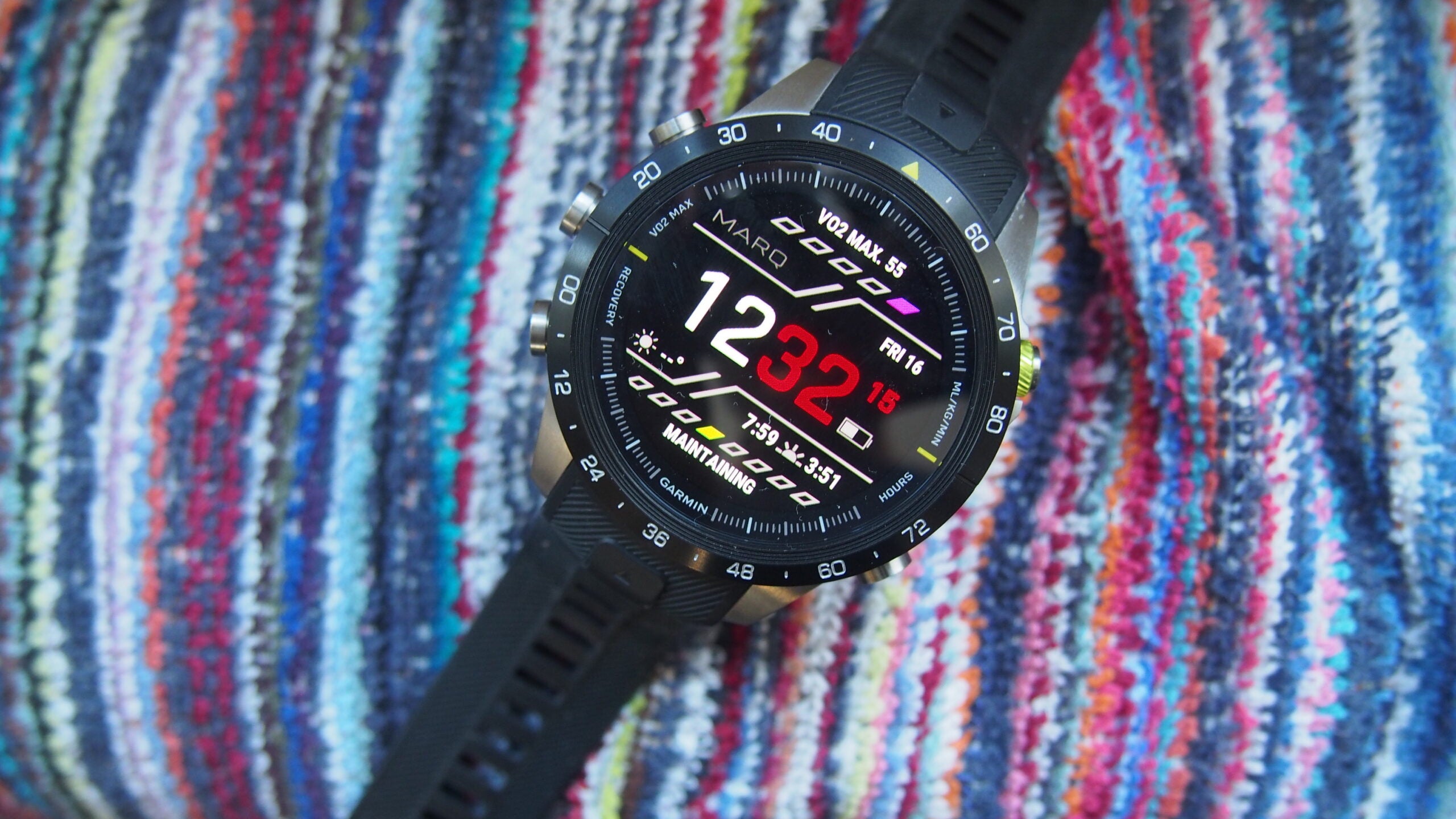The Garmin Marq 2 is a much nicer modern tool watch than the first Marq but if you’re hoping that high price also gets you a boatload more features than Garmin’s cheaper Fenix and Epix watches, then you’re sadly out of luck here.
Pros
- AMOLED screen elevates design from from first Marq
- Great sports tracking features
- Good battery life
Cons
- Can get most of same features for less
- Thicker than first Marq
- Not the biggest or best AMOLED on a Garmin watch
Availability
- UKRRP: £1599.99
- USARRP: $2100
Introduction
The Garmin Marq 2 is Garmin’s latest attempt to prove it can make a luxury watch that people will want to pay the big bucks for.
Costing considerably more than Garmin’s already pricey Fenix 7 series and Epix watches, the Marq 2 promises more high-grade materials, a colour display and more sports, outdoor and smartwatch features packed into an elegant design.
Those new features include Garmin’s multi-band mode to deliver more accurate positioning tracking, software features like Training Readiness to assess your readiness to train and a jet lag advisor to help you adjust to a new time zone.
The question is whether Garmin has done enough with the Marq 2 to make it a truly desirable luxury smartwatch you’ll want to spend the big cash on.
Design and screen
- New AMOLED touchscreen display
- Grade 5 Titanium case and bezel
- 46 mm case size only
- Waterproof up to 100 metres
Garmin refers to the Marq as a modern tool watch and what that means, in reality, is that it wants to put a Garmin on your wrist that’s still a sports watch at heart but with a more classic timepiece exterior.
The Athlete model I am using here is one of five watches that feature in the Marq range and as the name suggests, is one for sportier folk. For the new Athlete, Garmin has largely stuck to the same look with coloured accents on the buttons and a big chronograph-style bezel. It still comes in a 46mm case size, which is now thicker at 15mm (up from 14.1mm) but is lighter going from 94g to 85g.
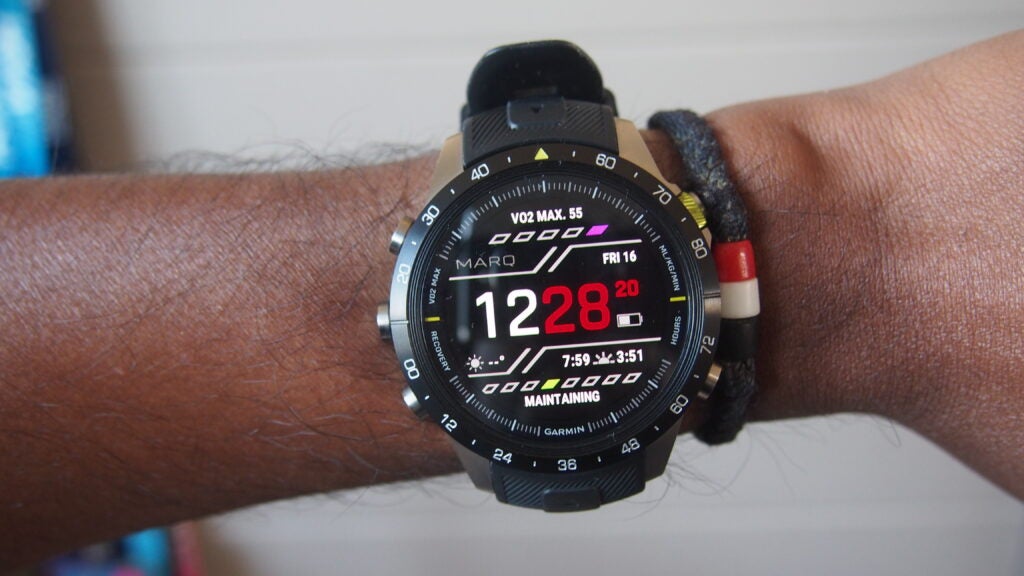
Garmin packs in a new Grade 5 titanium case and bezel giving it a much tougher version of titanium that also keeps the overall weight down. It’s these high-grade materials along with a domed sapphire crystal lens that you’re paying for here and it does create a classier-looking Garmin watch. It was the same story on the first Marq, but it was let down by the lack of a similarly high-quality screen to match that luxury exterior. Fortunately, that’s changed with the new Marq.
You’re getting a 1.2-inch, 390 x 390 resolution AMOLED touchscreen, which is actually a smaller and lower resolution AMOLED screen included on the significantly cheaper Garmin Venu 2. It’s a sharp, vibrant screen that’s easy to view, though it would’ve been nicer if it was a little larger. It’s one you can set to be always-on and if not, you’ve got a swift and responsive raise-to-wake gesture support to make use of instead.
That titanium case features five physical buttons and is partnered up with a 22mm removable silicone strap, which uses metal lug connectors to keep the strap in place. If you want to go deep in the water with it, the 10 ATM water rating means you can submerge it in water up to 100 metres depth.
The Marq feels like a more sophisticated version of Garmin’s Fenix and Epix watches and now has that colour screen to elevate its look. It’s thicker than the first Marq and those other Garmin watches, which did make a bit too much watch for our slender wrists. As far as delivering a Garmin that looks and feels like a tool watch, I’d say that there are other Marq models in the range that do a far better job of it.
Software and smartwatch features
- Works with Android and iOS
- Touchscreen support for navigation
- No LTE, voice features like Forerunner 945 and Venu 2 Plus
The Marq uses Garmin’s own in-house software and in true high-end Garmin watch fashion, it can take some time to get to grips with the number of menus and features.
The Garmin Connect smartphone app is as detailed and data-packed as ever, so it pays to spend some time getting to know what this watch is fully capable of. On the watch, the addition of touchscreen support definitely makes it a nicer navigation experience. You can swipe up or down from the watch face to get to your stream of Glances (widgets).
It’s your typical Garmin button layout here as well and those buttons have a lovely polished finish to them. If you’ve used a Garmin wearable before, this layout will feel familiar. If not, it is a lot to take in. The software runs well though, that touchscreen is nice and responsive and there’s scope to keep your tracking experience as simple or detailed as you’d like.
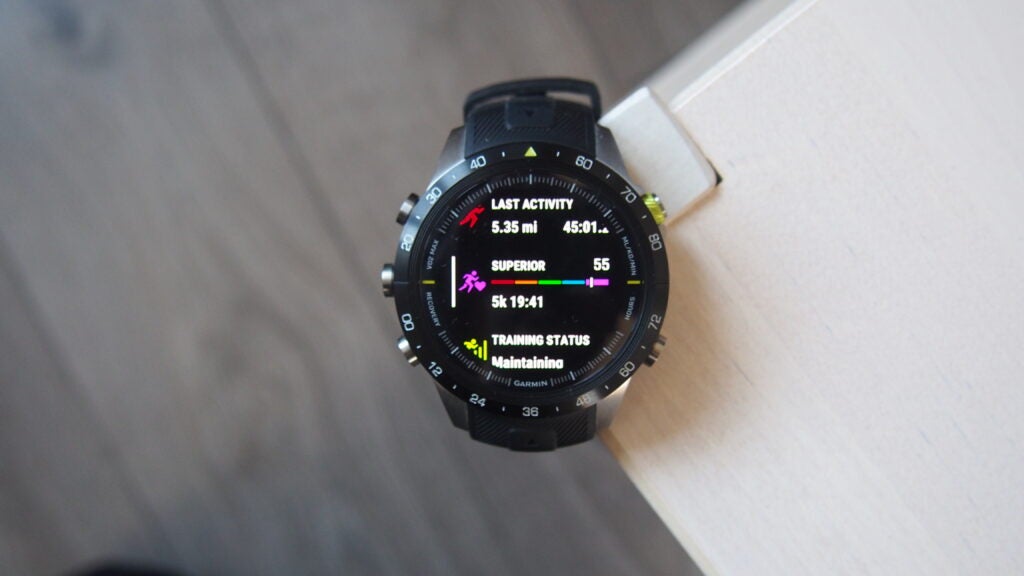
As a smartwatch, the Marq offers enough to make it useful to wear outside of workout tracking. It handles displaying phone notifications well, and you’ve got good music controls along with support for streaming services like Spotify. Garmin’s stock tracker that shows 50 of your favourite stocks gives it more business appeal and you do have Garmin’s Pay contactless payment support, which still doesn’t support a huge array of banks.
There’s access to Garmin’s Connect IQ Store but it isn’t in the same league as Apple or Google’s app storefronts. Garmin doesn’t include the LTE-enabled safety features included on the Forerunner 945 or the smartphone voice assistant and ability to take calls, which Garmin introduced on the Venu 2 Plus, but those don’t feel like they are hugely missed features.
While it might not give you everything Garmin has to offer in smartwatch features, what is here does give you a good smartwatch whether you’re pairing it up to an iPhone or an Android phone.
Fitness tracking
- Preloaded TOPO maps
- Multi-band and Sat IQ technology
- New jet lag recovery advisor
The new Marq essentially gives you everything you get on Garmin’s Fenix and Epix plus one notable software extra, which might be a desirable feature to regular jet setters.
Compared to the original Marq, there’s actually a lot that’s new here. While the first version now offers Garmin’s HRV Status mode, it lacks the Training Readiness mode, which uses that HRV data along with other metrics to better assess how well recovered you are for tougher training.
There’s now also the ability to view wrist-based running power, though you can get that data via an external sensor with the first gen Marq. You’re getting Garmin’s handy Morning Report feature to run down your day for you, whether that’s the weather, offering suggested workouts or showing you last night’s sleep data.
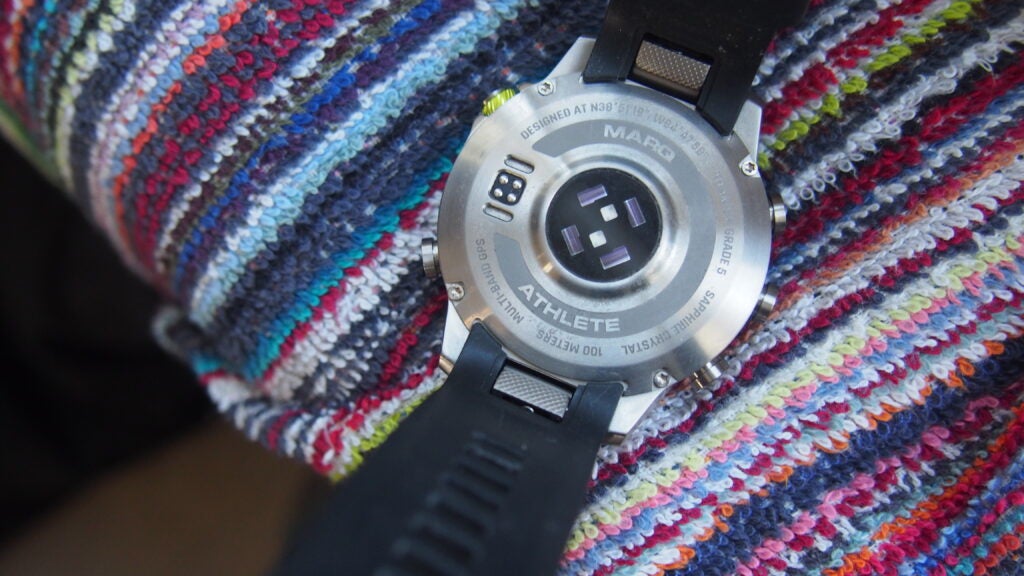
Garmin is now also including its multi-band GNSS and SATIQ satellite technology here too. The former aims to deliver more accurate positioning tracking in problematic areas like heavily forested areas or exploring a city with lots of tall buildings. Like its presence on the Epix, Fenix 7 and the Forerunner 955, it also does the business on the Marq too and offers reliable data overall.
Garmin includes preloaded Topo maps like the first Marq, but now looking over those maps is a much nicer experience with that AMOLED screen. Garmin offers arguably the best mapping and navigation experience on a sports watch and it’s more of the same on the Marq. You get nicely detailed maps, good turn-by-turn navigation and it’s nice and straightforward to get new routes uploaded to the watch via the Garmin Connect companion app.
One new feature you don’t get on other Garmin watches is a jet lag advisor. This feature is designed to help make the transition to another time zone a smoother one by offering advice on the ideal sleep schedule leading up to a flight, when to exercise and when to seek or avoid light.
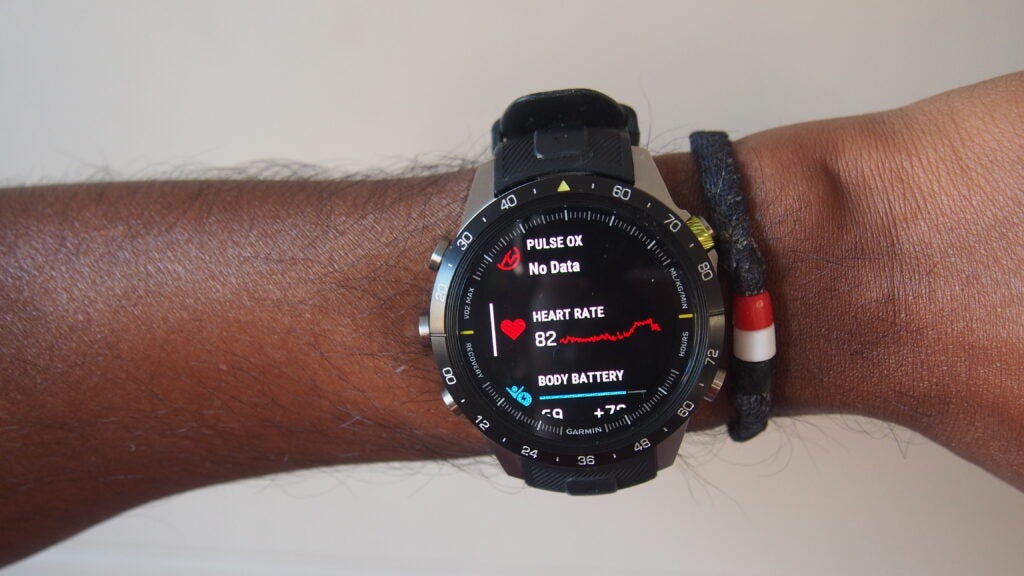
You’ll need to manually upload when you’re flying into the Garmin Connect app and then from the jet lag advisor widget on the watch, it’ll start to offer that guidance and let you know the level of jet lag you can experience.
It’s a feature designed for trips that last longer than 72 hours and while I, unfortunately, didn’t have anywhere to escape to during testing, we do like the idea of this feature making the Marq a more travel-friendly watch. That being said, it’s a feature that is expected to roll out to Garmin’s Epix and Fenix watches, so it won’t be a unique feature for long.
Ultimately, outside of that jet lag advisor, I can’t see anything that separates the Marq from the cheaper Fenix 7 and Epix in terms of fitness and sports tracking. That means you get a bountiful amount of sports modes and training and coaching features like Training Readiness, great mapping support for outdoor activities including golf and skiing and crucially, the kind of data you can rely on as well. There are plenty of reasons here for Marq users to want to upgrade to the new Marq, but the same can’t be said if you already own a new Fenix or Epix.
Battery life
- Up to 16 days of smartwatch battery life
- 6 days with always-on display mode
- Up to 75 hours in maximum GPS battery mode
Big battery life is pretty much a given on a Garmin watch and the Marq 2 promises to put in a good performance, even with that added AMOLED display.
Garmin says you can expect to get up to 16 days when using the Marq as a smartwatch (so, no GPS tracking basically), which is up 4 days from the first Marq.
If you keep that display on 24/7, that number drops dramatically to 6 days to give you an idea of how much power that display hogs.
When it comes to tracking, you’ve got up to 75 hours in the Max Battery GPS mode or 14 days in Expedition mode sampling GPS at a much less frequent rate. If you’re going to use the most accurate multi-band GPS mode, then that drops to 28 hours. Opt for the GPS-only mode and it’s 42 hours, up from 28 hours on the Marq.
The Marq is good for a week between charges if you’re not using that always-on display, which puts it to around 3-4 days if you’re using GPS and features like music and full mapping and navigation features.
The GPS battery life is solid as well, even when using the more accurate and more power-hungry multi-band mode where drop-off for an hour’s use was around 3-4%. In much colder conditions for the same duration, the battery did manage to drop by 20%. Whether you go super accurate or pretty accurate, the GPS battery numbers are good here.
You’ve also got the bonus of Garmin’s Battery Saver and Power Modes to make sure you make the most of that battery before it’s time to charge and pick up Garmin’s proprietary plug charger, which differs from the one used on the majority of its watches.
Latest deals
Should you buy it?
If you want a Garmin watch with high-end styling: If you like the idea of a Garmin watch that’s big, bold and has classic watch styling, then the Marq Athlete (Gen 2) is for you.
You want the best value high-end Garmin watch: Save some money and grab the Epix instead if you want a feature packed Garmin that offers you largely the same features, performance and isn’t a bad looker if you go for the right model.
Final Thoughts
The second generation Garmin Marq does a much better job of selling that luxury tool watch vision thanks to the addition of an AMOLED screen.
Ultimately though, you could spend less on a Garmin Epix (Gen 2), dress it up with a more formal-friendly watch strap and get pretty much the same features bar a few extras that may well make its way to those slightly cheaper
Garmin watches in the near future. If you’re really sold on a bolder, titanium-on-titanium look, then the Marq 2 will appeal, but it remains a hard sell just like the first-gen Marq.
How we test
We thoroughly test every fitness tracker we review. We use industry standard testing to compare features properly and we use the watch as our main device over the review period. We’ll always tell you what we find and we never, ever, accept money to review a product.
FAQs
Yes, you can swim with the Marq Athlete thanks to the 10 ATM water rating, which makes it safe to be submerged in water up to 100 metres depth.
The Garmin Marq Athlete (Gen 2) doesn’t have the ability to take calls via LTE or Bluetooth like the Garmin Venu 2 Plus
The Garmin Marq 2 is a much nicer modern tool watch than the first Marq but if you’re hoping that high price also gets you a boatload more features than Garmin’s cheaper Fenix and Epix watches, then you’re sadly out of luck here.
Pros
- AMOLED screen elevates design from from first Marq
- Great sports tracking features
- Good battery life
Cons
- Can get most of same features for less
- Thicker than first Marq
- Not the biggest or best AMOLED on a Garmin watch
Availability
- UKRRP: £1599.99
- USARRP: $2100
Introduction
The Garmin Marq 2 is Garmin’s latest attempt to prove it can make a luxury watch that people will want to pay the big bucks for.
Costing considerably more than Garmin’s already pricey Fenix 7 series and Epix watches, the Marq 2 promises more high-grade materials, a colour display and more sports, outdoor and smartwatch features packed into an elegant design.
Those new features include Garmin’s multi-band mode to deliver more accurate positioning tracking, software features like Training Readiness to assess your readiness to train and a jet lag advisor to help you adjust to a new time zone.
The question is whether Garmin has done enough with the Marq 2 to make it a truly desirable luxury smartwatch you’ll want to spend the big cash on.
Design and screen
- New AMOLED touchscreen display
- Grade 5 Titanium case and bezel
- 46 mm case size only
- Waterproof up to 100 metres
Garmin refers to the Marq as a modern tool watch and what that means, in reality, is that it wants to put a Garmin on your wrist that’s still a sports watch at heart but with a more classic timepiece exterior.
The Athlete model I am using here is one of five watches that feature in the Marq range and as the name suggests, is one for sportier folk. For the new Athlete, Garmin has largely stuck to the same look with coloured accents on the buttons and a big chronograph-style bezel. It still comes in a 46mm case size, which is now thicker at 15mm (up from 14.1mm) but is lighter going from 94g to 85g.

Garmin packs in a new Grade 5 titanium case and bezel giving it a much tougher version of titanium that also keeps the overall weight down. It’s these high-grade materials along with a domed sapphire crystal lens that you’re paying for here and it does create a classier-looking Garmin watch. It was the same story on the first Marq, but it was let down by the lack of a similarly high-quality screen to match that luxury exterior. Fortunately, that’s changed with the new Marq.
You’re getting a 1.2-inch, 390 x 390 resolution AMOLED touchscreen, which is actually a smaller and lower resolution AMOLED screen included on the significantly cheaper Garmin Venu 2. It’s a sharp, vibrant screen that’s easy to view, though it would’ve been nicer if it was a little larger. It’s one you can set to be always-on and if not, you’ve got a swift and responsive raise-to-wake gesture support to make use of instead.
That titanium case features five physical buttons and is partnered up with a 22mm removable silicone strap, which uses metal lug connectors to keep the strap in place. If you want to go deep in the water with it, the 10 ATM water rating means you can submerge it in water up to 100 metres depth.
The Marq feels like a more sophisticated version of Garmin’s Fenix and Epix watches and now has that colour screen to elevate its look. It’s thicker than the first Marq and those other Garmin watches, which did make a bit too much watch for our slender wrists. As far as delivering a Garmin that looks and feels like a tool watch, I’d say that there are other Marq models in the range that do a far better job of it.
Software and smartwatch features
- Works with Android and iOS
- Touchscreen support for navigation
- No LTE, voice features like Forerunner 945 and Venu 2 Plus
The Marq uses Garmin’s own in-house software and in true high-end Garmin watch fashion, it can take some time to get to grips with the number of menus and features.
The Garmin Connect smartphone app is as detailed and data-packed as ever, so it pays to spend some time getting to know what this watch is fully capable of. On the watch, the addition of touchscreen support definitely makes it a nicer navigation experience. You can swipe up or down from the watch face to get to your stream of Glances (widgets).
It’s your typical Garmin button layout here as well and those buttons have a lovely polished finish to them. If you’ve used a Garmin wearable before, this layout will feel familiar. If not, it is a lot to take in. The software runs well though, that touchscreen is nice and responsive and there’s scope to keep your tracking experience as simple or detailed as you’d like.

As a smartwatch, the Marq offers enough to make it useful to wear outside of workout tracking. It handles displaying phone notifications well, and you’ve got good music controls along with support for streaming services like Spotify. Garmin’s stock tracker that shows 50 of your favourite stocks gives it more business appeal and you do have Garmin’s Pay contactless payment support, which still doesn’t support a huge array of banks.
There’s access to Garmin’s Connect IQ Store but it isn’t in the same league as Apple or Google’s app storefronts. Garmin doesn’t include the LTE-enabled safety features included on the Forerunner 945 or the smartphone voice assistant and ability to take calls, which Garmin introduced on the Venu 2 Plus, but those don’t feel like they are hugely missed features.
While it might not give you everything Garmin has to offer in smartwatch features, what is here does give you a good smartwatch whether you’re pairing it up to an iPhone or an Android phone.
Fitness tracking
- Preloaded TOPO maps
- Multi-band and Sat IQ technology
- New jet lag recovery advisor
The new Marq essentially gives you everything you get on Garmin’s Fenix and Epix plus one notable software extra, which might be a desirable feature to regular jet setters.
Compared to the original Marq, there’s actually a lot that’s new here. While the first version now offers Garmin’s HRV Status mode, it lacks the Training Readiness mode, which uses that HRV data along with other metrics to better assess how well recovered you are for tougher training.
There’s now also the ability to view wrist-based running power, though you can get that data via an external sensor with the first gen Marq. You’re getting Garmin’s handy Morning Report feature to run down your day for you, whether that’s the weather, offering suggested workouts or showing you last night’s sleep data.

Garmin is now also including its multi-band GNSS and SATIQ satellite technology here too. The former aims to deliver more accurate positioning tracking in problematic areas like heavily forested areas or exploring a city with lots of tall buildings. Like its presence on the Epix, Fenix 7 and the Forerunner 955, it also does the business on the Marq too and offers reliable data overall.
Garmin includes preloaded Topo maps like the first Marq, but now looking over those maps is a much nicer experience with that AMOLED screen. Garmin offers arguably the best mapping and navigation experience on a sports watch and it’s more of the same on the Marq. You get nicely detailed maps, good turn-by-turn navigation and it’s nice and straightforward to get new routes uploaded to the watch via the Garmin Connect companion app.
One new feature you don’t get on other Garmin watches is a jet lag advisor. This feature is designed to help make the transition to another time zone a smoother one by offering advice on the ideal sleep schedule leading up to a flight, when to exercise and when to seek or avoid light.

You’ll need to manually upload when you’re flying into the Garmin Connect app and then from the jet lag advisor widget on the watch, it’ll start to offer that guidance and let you know the level of jet lag you can experience.
It’s a feature designed for trips that last longer than 72 hours and while I, unfortunately, didn’t have anywhere to escape to during testing, we do like the idea of this feature making the Marq a more travel-friendly watch. That being said, it’s a feature that is expected to roll out to Garmin’s Epix and Fenix watches, so it won’t be a unique feature for long.
Ultimately, outside of that jet lag advisor, I can’t see anything that separates the Marq from the cheaper Fenix 7 and Epix in terms of fitness and sports tracking. That means you get a bountiful amount of sports modes and training and coaching features like Training Readiness, great mapping support for outdoor activities including golf and skiing and crucially, the kind of data you can rely on as well. There are plenty of reasons here for Marq users to want to upgrade to the new Marq, but the same can’t be said if you already own a new Fenix or Epix.
Battery life
- Up to 16 days of smartwatch battery life
- 6 days with always-on display mode
- Up to 75 hours in maximum GPS battery mode
Big battery life is pretty much a given on a Garmin watch and the Marq 2 promises to put in a good performance, even with that added AMOLED display.
Garmin says you can expect to get up to 16 days when using the Marq as a smartwatch (so, no GPS tracking basically), which is up 4 days from the first Marq.
If you keep that display on 24/7, that number drops dramatically to 6 days to give you an idea of how much power that display hogs.
When it comes to tracking, you’ve got up to 75 hours in the Max Battery GPS mode or 14 days in Expedition mode sampling GPS at a much less frequent rate. If you’re going to use the most accurate multi-band GPS mode, then that drops to 28 hours. Opt for the GPS-only mode and it’s 42 hours, up from 28 hours on the Marq.
The Marq is good for a week between charges if you’re not using that always-on display, which puts it to around 3-4 days if you’re using GPS and features like music and full mapping and navigation features.
The GPS battery life is solid as well, even when using the more accurate and more power-hungry multi-band mode where drop-off for an hour’s use was around 3-4%. In much colder conditions for the same duration, the battery did manage to drop by 20%. Whether you go super accurate or pretty accurate, the GPS battery numbers are good here.
You’ve also got the bonus of Garmin’s Battery Saver and Power Modes to make sure you make the most of that battery before it’s time to charge and pick up Garmin’s proprietary plug charger, which differs from the one used on the majority of its watches.
Latest deals
Should you buy it?
If you want a Garmin watch with high-end styling: If you like the idea of a Garmin watch that’s big, bold and has classic watch styling, then the Marq Athlete (Gen 2) is for you.
You want the best value high-end Garmin watch: Save some money and grab the Epix instead if you want a feature packed Garmin that offers you largely the same features, performance and isn’t a bad looker if you go for the right model.
Final Thoughts
The second generation Garmin Marq does a much better job of selling that luxury tool watch vision thanks to the addition of an AMOLED screen.
Ultimately though, you could spend less on a Garmin Epix (Gen 2), dress it up with a more formal-friendly watch strap and get pretty much the same features bar a few extras that may well make its way to those slightly cheaper
Garmin watches in the near future. If you’re really sold on a bolder, titanium-on-titanium look, then the Marq 2 will appeal, but it remains a hard sell just like the first-gen Marq.
How we test
We thoroughly test every fitness tracker we review. We use industry standard testing to compare features properly and we use the watch as our main device over the review period. We’ll always tell you what we find and we never, ever, accept money to review a product.
FAQs
Yes, you can swim with the Marq Athlete thanks to the 10 ATM water rating, which makes it safe to be submerged in water up to 100 metres depth.
The Garmin Marq Athlete (Gen 2) doesn’t have the ability to take calls via LTE or Bluetooth like the Garmin Venu 2 Plus


















